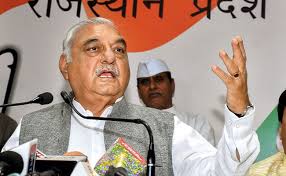The Congress, which won five out of the 10 Lok Sabha seats in the state, saw its vote share climbing to over 43 per cent from 28 per cent in 2019. This resurgence is a shot in the arm for the party as it has registered a lead on 46 assembly segments out of total 90 in state. A report by Aayush Goel

The 2024 Lok Sabha polls will always be remembered for the commendable comeback by the Congress in Haryana. Shattering the pompous pre-poll predictions of BJP’s clean sweep in state, Congress went on to win five out of the 10 Lok Sabha seats with its vote share increasing to over 43 per cent from 28 per cent in 2019. In 2014, the party had managed to win one parliamentary seat of Rohtak, while losing all 10 to the BJP in 2019.
The party proved its mettle even in BJP stronghold seats like Gurgaon where ‘outsider’ Raj Babbar gave Ahir stalwart and a six time MP and Central minister, Rao Inderjit Singh, a run for his money and brought down winning margin to a modest 75000.

This resurgence is being viewed as a shot in the arm for the party ahead of assembly polls due in October as it registered a lead on 46 assembly segments out of 90 in state. The vote share of the BJP, which also won five seats, losing five others to the Congress, slipped from 58 per cent in 2019 to nearly 46 per cent this time. The AAP, which contested as part of the INDIA bloc on one seat, failed to open its account in Haryana with nearly 3.94 per cent vote share. While the result has given the Congress the much needed confidence, it has compelled the BJP and the AAP to rework their strategies for the forthcoming assembly polls.
Results at a glance
The most celebrated and anticipated wins for Congress were of former Union minister Kumari Selja and Deepender Singh Hooda. Selja defeated Ashok Tanwar of the BJP at Sirsa by a margin of 2.68 lakh votes, while Hooda defeated BJP’s Arvind Sharma by 3.45 lakh votes at Rohtak. Congress candidates Jai Parkash won from Hisar by 63,381 votes, while Varun Chaudhary clinched Ambala by 49,036 votes, and Satpal Brahmachari won Sonipat by 21,816 votes.
The detailed analysis of the impact of these wins on assembly segments highlights Congress’s winning strategy that left an impact despite lagging behind BJP in declaration of candidates. Kumari Selja and Deepender Singh Hooda got more votes than their rivals in all 9 assembly segments each in Sirsa and Rohtak. Among the Congress candidates, they got the lead in five out of 9 assembly segments in Ambala, four out of 9 in Sonipat, and six out of 9 in Hisar. As for the seats won by the BJP, the Congress and AAP candidates got the lead on four out of 9 assembly segments in Kurukshetra, 3 out of 9 in Bhiwani-Mahendragarh, three out of 9 in Gurgaon, and 3 out of 9 assembly seats in Faridabad. Former chief minister Manohar Lal Khattar, however, had the lead in all 9 assembly segments falling under Karnal. Of the 10 assembly segments that Dushyant Chautala’s Jannayak Janata Party (JJP) won in October 2019, the Congress got the lead in 9, with only Barwala giving a lead of 11,657 votes to the BJP.
Interestingly, Congress’s Jai Parkash led over his BJP rival by 37,319 votes in Dushyant Chautala’s Uchana seat, while another Congressman Rao Dan Singh led by 27,102 votes over the BJP contestant in Naina Chautala’s Badhra constituency.
Will return to power: Hooda
Leader of Opposition Bhupinder Singh Hooda said that party was confident of its performance in Lok Sabha and the results now indicate they will be winning with majority in Vidhan Sabha as well. “The people of Haryana have had enough of fake promises of BJP and the Lok Sabha results are an indication of a clear verdict against the party. We may have won 5 seats but if you analyse the remaining 5 we lost we had a major impact in BJP’s assembly segments. Our candidates have taken the lead on 46 assembly segments, which is more than half of the total seats. So while elections are three months away the trends reveal what the results will be even then. The issues during assembly polls are different and we will definitely get many more seats than 46 in the assembly polls. We will return to power in the state with a majority,” said Hooda while speaking to Tehelka. It may be noted that Hooda played a key role in ticket allocation of Lok Sabha polls amidst factionalisation in the party as 4 out of 5 winners are from Hooda camp.
While the party is celebrating the comeback, many other veteran leaders’ results could have been much better if the party had not downplayed and ignored veterans like Kiran Choudhry and her daughter Shruti Choudhry. “We could have won three more seats if candidates were chosen keeping caste and impact equations. We could have easily won Gurgaon if I had been fielded. Cold shouldering Choudhry’s cost us Bhiwani-Mahendergarh. We just want to ensure that the party high command keeps this in mind while choosing assembly candidates,” says another Congress veteran and party’s OBC cell chairman, Captain Ajay Yadav, while talking to Tehelka.
Alarm bells for BJP
Results of the Lok Sabha elections in the state have rung alarm bells for BJP that managed to retain only five seats. The party was completely wiped out in most of ‘Jatland’.
In some assembly constituencies, where the party had claimed ‘permanent dominance’, its Lok Sabha candidates were defeated. The foremost example of the same is the Ambala Lok Sabha constituency where BJP candidate Banto Kataria lost. In Naraingarh assembly segment, which was represented by chief minister Nayab Singh Saini in 2014-2019, Kataria was defeated by more than 20,000 votes. Similarly, in Jagadhri assembly segment, which is represented by Haryana minister Kanwar Pal, Kataria was defeated by around 15,000 votes. In Ambala city assembly segment, represented by state’s Transport Minister Aseem Goyal, Kataria lost by around 4,000 votes. However, in Ambala Cantonment segment, which is represented by former home minister Anil Vij, Kataria managed some lead over her Congress opponent.
A similar situation of lead by Congress candidates was witnessed in assembly segments where party’s prominent leaders or ministers are MLAs, such as Pehowa, represented by controversial former minister and former Olympian Sandeep Singh, Kalayat represented by former minister Kamlesh Dhanda, Bawani Khera represented by minister Bishambar Balmiki, Nalwa represented by deputy speaker Ranbir Singh Gangwa, Rania in Sirsa (reserved) seat represented by Ranjit Chautala, and Loharu under Bhiwani-Mahendragarh Lok Sabha seat represented by state minister J P Dalal.
In Nangal-Chaudhary represented by irrigation minister Abhay Yadav, the BJP candidate could only manage a lead of just a little more than 2,000 votes. The results have put the party in a review mode, which in addition to rampant anti-incumbency, also has to deal with resentment amongst MLAs, majority of whom did not care to support the party’s Lok Sabha choices.
The party has failed to strike a chord with rural voters and Jats who could play a decisive role in the upcoming assembly elections. Jats, who constitute over 25 percent of the population, hold the key to around 40 assembly seats. Similarly 65 percent of the population resides in rural belts and villages and the party needs to win them over to do better in assembly elections.
Haryana BJP chief and party’s national secretary O.P. Dhankhar says “The results of the Parliamentary polls are not as per our expectation, and there is no denying that everyone in the party is worried about it, particularly because the assembly polls are due in October. We are on the job of identifying what went wrong and tweaking the strategy before the forthcoming assembly polls.”













